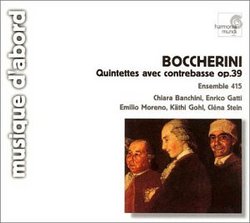| All Artists: Luigi Boccherini, Ensemble 415 Title: Luigi Boccherini: Quintettes Avec Contrebasse Members Wishing: 0 Total Copies: 0 Label: Harmonia Mundi Fr. Release Date: 11/14/2000 Album Type: Import, Original recording reissued Genre: Classical Styles: Chamber Music, Historical Periods, Classical (c.1770-1830) Number of Discs: 1 SwapaCD Credits: 1 UPC: 794881508327 |
Search - Luigi Boccherini, Ensemble 415 :: Luigi Boccherini: Quintettes Avec Contrebasse
 | Luigi Boccherini, Ensemble 415 Luigi Boccherini: Quintettes Avec Contrebasse Genre: Classical
|
Larger Image |
CD Details |
CD ReviewsDeep, Wistful, Strong, Icy, Warm, Delicate, Rich, Forlorn, S N. Cook | 06/16/2008 (5 out of 5 stars) "Wow! I wholeheartedly agree with the other reviewer's enthusiasm about this album. These three Bass Quintets are well worth the purchase of this disk, perhaps even if you don't like "classical" music. The entire string spectrum is intertwined from violin to double bass and the results are simply sumptuous! The highlights here are as follows: The first quintet doesn't draw its strength nearly as much from the beauty of its themes (especially the beauty of its Rendeau) as from the alternations between joy and introspection, fast and slow. This keeps things very interesting throughout. The second quintet sets you up to think its a carefree, almost silly piece by its opening movement. You couldn't be more wrong! Its Adagio is as gorgeous and delicate as a butterfly emerging slowly from a chrysalis and letting its wings take shape. Utterly enrapturing and enchanting. You'll definitely stop what you're doing and just sit with eyes closed - listening. It has a feel akin to the Largo from Vivaldi's "Winter." The closing Finale warms things up again just right. My favorite of all is #3. From its opening bars it is pure gold. The entire quintet is warm, regal, and inviting, like a joy-filled room with a warm fireplace. The main theme of the Allegro is one of those "quintessential" sounding melodies that you're sure to spontaneously hum to. It has a very catchy charm. The solo passages are performed on either the cello or the bass (or alternately both as my ear isn't that tuned yet) as if it is a violin and are summed up on the instrument by the richest ties I've heard. Its Pastorale lulls you with its reassuring ease and gentle genius before the Finale gets you back on your feet, romping around the room. This disk ends with a curious little quartet called "La Tirana," the name of which is open to speculation, the loveableness of which is not. In all this is a HIGHLY "worth it" album!" Don't wait! Giordano Bruno | Wherever I am, I am. | 05/17/2008 (5 out of 5 stars) "Straight from the shoulder! Don't bother to read this review. Pop this CD in your cart and be sure to pay for rapid shipping. This performance is too good to waste another week of your life without hearing...
...but if you're not confident of my judgement, I suppose I'll have to rhapsodize a while. Imagine four beautiful children, ages eight, ten, thirteen and sixteen, romping in a formal garden. The younger two are turning cartwheels, playing leag-frog. The thirteen-year-old, a chestnut beauty, frisks with her sibs but shows a pensive restraint about lifting her skirts. The eldest pirouettes amid the little ones with consummate sensual elegance. A sturdy chaperon, perhaps a youthful grandfather, stands sentinel, apart yet sometimes tempted to venture a twirl. The little ones are the violins, the older pair are the viola and cello, and the guardian is the contrabass. Boccherini wrote only three of his hundred-plus string quintets using a contrabass instead of a second cello. There was undoubtedly a practical occasion for his choice, since Boccherini wrote nearly all of his music to be played, and played well, in company the next day. It might be of some significance that his father in Italy had been an accomplished performer of the contrabass. In any case, Boccherini distilled all his love of music and good company in these three quintets, which are among the finest he ever wrote. The structure of the quintets is original and effective. As usual, the most virtuosic passages are given to the cello, Boccherini's own instrument, but the melodic development is evenly distributed among the four voices of the quartet, showing a compositional maturity not matched even by Mozart until his last great works. The contrabass does not join the quartet in thematic development but rather provides a kind of continuo, a harmonic ground not unlike the role of the bass fiddle in a jazz ensemble. All the charms of "extended" technique on strings - pizzicato, bridge tones, double stops, col legno (with the wood of the bow) - are employed for excitement, but with superb restraint and musical integration. One can only wonder what rapture the circle of Boccherini's patron/friends must have felt when playing such glorious music for the first time. Ensemble 415? Do you understand the significance of the name? The 415 refers to tuning the instruments at "chamber" pitch, lower than the usual A440 of modern orchestras, as was common practice in the 17th and 18th Centuries. With the gut strings of pre-modern fiddles, the lower pitch produces a distinctively mellow tone that can still be highly passionate. Ensemble 415 plays their chosen 18th C repertoire with deft fervor and impeccable technique. I heartily recommend running an amazon search and buying everything they've recorded. And I don't even have a cousin amongst them!" |

 Track Listings (12) - Disc #1
Track Listings (12) - Disc #1